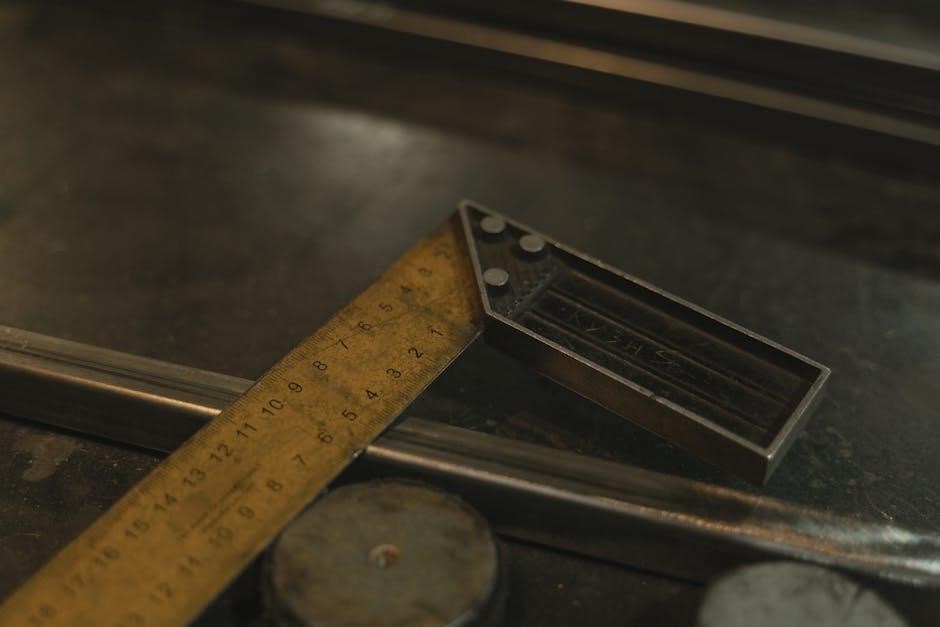Standard spline shaft dimensions are critical in mechanical engineering, ensuring proper fitment and functionality. They are standardized by organizations like DIN, ISO, SAE, and ANSI, providing uniform specifications. While custom dimensions are common, adhering to standards ensures compatibility and optimal performance across applications. Understanding these dimensions is essential for design and manufacturing processes.
Overview of Spline Shafts
Spline shafts are cylindrical components featuring equally spaced grooves or teeth, enabling torque transmission and axial movement. They are designed for precise connections in mechanical systems, ensuring rotational stability and flexibility. Common types include straight-sided and involute splines, each offering distinct performance characteristics. Straight-sided splines are simpler and often used in lighter applications, while involute splines provide higher strength and are preferred in demanding environments. Spline shafts are integral to gearboxes, automotive drivetrains, and industrial machinery, offering reliable power transfer. Their design and dimensions are standardized to ensure compatibility and optimal performance across various industries, making them a critical component in modern engineering.

Importance of Standard Dimensions in Mechanical Engineering
Standard dimensions in mechanical engineering ensure compatibility, interchangeability, and reliability of components. For spline shafts, adhering to standardized dimensions guarantees precise fitting with mating parts, minimizing wear and enhancing performance. These standards, often outlined in resources like the “standard spline shaft dimensions PDF,” provide a universal framework for manufacturers, reducing design variability and production costs. They also facilitate easier maintenance and repair by ensuring replacement parts are readily available. Compliance with standards like DIN, ISO, and ANSI fosters trust and consistency across industries, enabling engineers to focus on innovation rather than foundational design. This uniformity is critical for safety and efficiency in complex systems.

Standards Governing Spline Shaft Dimensions
Global standards like DIN, ISO, SAE, and ANSI regulate spline shaft dimensions, ensuring compatibility, manufacturability, and safety across industries. These specifications are detailed in resources like the “standard spline shaft dimensions PDF” for precise design and manufacturing guidance.
DIN Standards for Spline Shafts
DIN standards provide precise specifications for spline shaft dimensions, ensuring uniformity and interchangeability in mechanical systems. These standards, detailed in resources like the “standard spline shaft dimensions PDF,” cover dimensions, tolerances, and materials. They define key parameters such as pitch diameter, major and minor diameters, and spline lengths, ensuring compatibility across components. DIN standards also address manufacturing tolerances and surface finishes, critical for operational reliability. Compliance with these standards enhances product quality and facilitates global market acceptance, making them indispensable for engineers and manufacturers working with spline shafts.
ISO Standards for Spline Shafts
ISO standards for spline shafts provide internationally recognized specifications, ensuring global compatibility and consistency. These standards, detailed in resources like the “standard spline shaft dimensions PDF,” define key parameters such as pitch diameter, major and minor diameters, and tooth proportions. ISO guidelines also cover surface finish requirements and tolerances, crucial for ensuring proper fit and function. Widely adopted across industries, ISO standards facilitate the design and manufacturing of spline shafts for applications ranging from automotive to aerospace. By adhering to ISO standards, manufacturers can ensure their products meet international quality benchmarks, promoting reliability and interchangeability in mechanical systems worldwide.
SAE Standards for Spline Shafts
SAE (Society of Automotive Engineers) standards for spline shafts are widely adopted in the automotive and aerospace industries. These standards, detailed in resources like the “standard spline shaft dimensions PDF,” specify requirements for spline shaft design, including tooth geometry, pitch diameters, and tolerances. SAE standards ensure compatibility and interchangeability of components, which is critical for maintaining consistency in mechanical systems. They also address material quality and surface finish, ensuring durability and performance. By adhering to SAE standards, manufacturers can produce spline shafts that meet rigorous industry expectations, particularly in high-stress applications like vehicle drivetrains and industrial machinery.
ANSI Standards for Spline Shafts
ANSI (American National Standards Institute) standards for spline shafts provide detailed specifications for dimensions, tolerances, and materials. These standards, often referenced in documents like the “standard spline shaft dimensions PDF,” ensure interchangeability and consistency in design. ANSI standards cover key aspects such as spline tooth profiles, pitch diameters, and surface finishes. They also specify acceptable tolerances for major and minor diameters, ensuring proper fitment and functionality. ANSI standards collaborate with other organizations like SAE and ISO to maintain compatibility. By adhering to these standards, manufacturers can produce spline shafts that meet stringent quality and performance requirements across various industries.

Types of Spline Shafts
Spline shafts are categorized into straight-sided and involute types. Straight-sided splines have parallel teeth, while involute splines feature curved teeth for higher load capacity and durability.

Straight-Sided Splines
Straight-sided splines are characterized by their parallel, non-tapered teeth, offering simplicity in design and manufacturing. They are typically used in low-load applications due to their straightforward tooth profile. These splines provide minimal stress concentration and are often found in gearboxes and mechanical transmissions. Standard dimensions for straight-sided splines are detailed in specifications like DIN, ISO, and ANSI, ensuring uniformity across industries. They are commonly fabricated from steel alloys or stainless steel, depending on the required strength and environmental conditions. Despite their simplicity, straight-sided splines play a crucial role in various mechanical systems, particularly where ease of assembly and maintenance are prioritized.
Involute Splines
Involute splines feature curved teeth, similar to those found in gears, providing superior load-carrying capacity and resistance to wear. They are widely used in high-torque and high-stress applications, such as automotive and aerospace industries. The involute profile ensures even load distribution, minimizing stress concentration. Standard dimensions for involute splines are governed by specifications like DIN and ISO, ensuring compatibility and interchangeability. These splines are typically manufactured from high-strength materials, such as steel alloys, to withstand demanding operating conditions. Their design allows for smooth engagement and disengagement, making them ideal for applications requiring precision and durability. This design is preferred for critical mechanical systems.

Materials Used for Spline Shafts
Spline shafts are typically made from high-strength materials like steel alloys, stainless steel, and sometimes titanium for aerospace applications. These materials ensure durability, strength, and resistance to wear and corrosion, meeting the demands of various industrial applications.
Steel Alloys in Spline Shafts
Steel alloys are the most commonly used materials for spline shafts due to their high strength, durability, and cost-effectiveness. Alloys like AISI 4140 and 8620 are widely used, offering excellent tensile strength and toughness. These materials are ideal for withstanding the mechanical stresses and torques exerted on spline shafts in demanding applications. The use of steel alloys ensures minimal wear and tear, extending the lifespan of the shaft. Additionally, steel alloys can undergo heat treatment to enhance their mechanical properties, making them suitable for high-performance requirements in industries such as automotive and heavy machinery.
Stainless Steel in Spline Shafts
Stainless steel is a preferred material for spline shafts in environments requiring high corrosion resistance. Grades like 304 and 316 are commonly used due to their excellent resistance to rust and chemicals. Stainless steel spline shafts are ideal for applications in food processing, marine, and medical industries where hygiene and durability are critical. While they may not offer the same strength as steel alloys, stainless steel shafts provide a balance of strength and corrosion resistance. Their smooth surface finish also reduces friction, enhancing operational efficiency. However, they are typically more expensive than steel alloys, limiting their use to specialized applications.

Applications of Spline Shafts
Spline shafts are essential in power transmission systems, widely used in automotive, industrial, and aerospace applications for precise torque transfer and rotational stability in mechanical systems.
Automotive Industry Applications
In the automotive sector, spline shafts are critical for power transmission systems, ensuring smooth torque delivery. They are commonly used in manual transmissions, drivetrain components, and gearboxes. Spline shafts in vehicles withstand high stress and torque, enabling efficient energy transfer between engine and wheels. Their precise dimensions, as per standard specifications, ensure reliability and durability in harsh operating conditions. Automotive applications rely on these shafts for consistent performance, making them indispensable in modern vehicle design. Standard spline shaft dimensions are essential for compatibility and optimal functionality in automotive systems.
Industrial Machinery Applications
Spline shafts are extensively used in industrial machinery for transmitting rotational motion and torque. They are integral to gear systems, pumps, and heavy-duty equipment, ensuring precise power transfer. In manufacturing, these shafts are employed in machinery like CNC machines, conveyor systems, and robotics. Their durability and resistance to wear make them ideal for high-load industrial environments. Standard dimensions ensure compatibility and ease of maintenance, while their strength and rigidity support continuous operation. Spline shafts play a vital role in maintaining efficiency and productivity in industrial settings, making them a cornerstone of modern machinery design and functionality.
Aerospace Industry Applications
Spline shafts are critical in aerospace applications, where precision and reliability are paramount; They are used in aircraft engines, gearboxes, and landing gear systems to transmit torque and rotational motion. The high strength-to-weight ratio of spline shafts makes them ideal for aerospace, minimizing weight while maintaining durability. Standard dimensions ensure compatibility across components, simplifying maintenance and reducing failure risks. Aerospace-grade materials, such as high-strength steel and titanium alloys, are selected for their resistance to fatigue and corrosion. These shafts must withstand extreme conditions, including vibration and temperature fluctuations, making their design and manufacturing highly specialized. They are essential for ensuring the safety and performance of aircraft systems.

Dimensions and Tolerances
Standard spline shaft dimensions ensure compatibility and reliability in power transmission systems. Tolerances are critical for proper fitment, minimizing wear and optimizing performance across mechanical applications.
Pitch Diameter and Its Significance
The pitch diameter is a critical dimension in spline shaft design, representing the average diameter of the spline teeth. It ensures proper fitment between mating components, minimizing wear and maximizing torque transmission. Accurate pitch diameter measurements are essential for maintaining alignment and preventing premature failure. Tolerances are tightly controlled to accommodate assembly stresses and operational loads. The pitch diameter directly influences the distribution of stress across the spline teeth, making it vital for reliable performance in high-torque applications. Proper alignment and precision manufacturing are required to achieve optimal pitch diameter specifications, ensuring long-term durability and efficiency in mechanical systems.
Major and Minor Diameters
The major diameter refers to the maximum diameter of the spline teeth, while the minor diameter is the smallest diameter at the root of the teeth. These dimensions are critical for ensuring proper fitment between the spline shaft and its mating component. The major diameter determines the overall strength and torque capacity of the spline, while the minor diameter provides clearance for assembly and lubrication. Tolerances for these diameters are tightly controlled to ensure optimal performance and prevent wear. Standardized dimensions for major and minor diameters are specified in engineering standards to guarantee compatibility and reliability across various applications and industries.
Spline Length Considerations
Spline length is a critical factor in ensuring proper torque transmission and mechanical stability. The length must be sufficient to handle the applied load without causing excessive stress or deflection. Longer splines generally provide greater strength and rigidity, but they may not be suitable for applications with space constraints. Designers must balance the required spline length with the overall shaft dimensions to ensure compatibility. Standards often provide guidelines for minimum and maximum spline lengths based on pitch and diameter. Proper alignment and installation are also essential to prevent uneven wear and ensure optimal performance over the spline’s operational life.

Manufacturing Processes
Manufacturing processes for spline shafts include hobbing, grinding, and milling. These methods ensure precise dimensions and smooth surfaces. Quality control measures guarantee compliance with standards.
Hobbing Process for Spline Shafts
The hobbing process is a precise machining method used to manufacture spline shafts. It involves using a hob cutter, which rotates and moves along the shaft, cutting the spline teeth. This process ensures high accuracy and uniformity in the spline dimensions. Hobbing is particularly effective for creating straight-sided and involute splines, as it maintains tight tolerances. The cutter’s geometry and the machining parameters are carefully controlled to meet standard dimensions. Hobbing is widely used in industrial applications due to its efficiency and ability to produce complex spline profiles with minimal material waste. It is a key process in achieving precise spline shaft manufacturing.
Grinding Process for Precision Splines
The grinding process is a high-precision machining method used to finish spline shafts, ensuring tight dimensional tolerances and smooth surface finishes. It is often employed after hobbing to refine the spline teeth. Grinding involves using specialized grinding wheels, such as diamond-coated tools, to remove minimal material while achieving exacting standards. This process is critical for applications requiring low surface roughness and precise fit. The grinding process is particularly effective for hard or hardened materials, ensuring the spline shaft meets stringent specifications. It is a cornerstone in manufacturing high-performance spline shafts for demanding industries like aerospace and automotive.

Design Considerations
Proper design ensures spline shafts handle torque, stress, and wear efficiently. Material selection, tooth geometry, and fit between shaft and hub are critical for optimal performance and longevity.
Stress Concentration Factors
Stress concentration factors are critical in spline shaft design, as they determine the points where mechanical stress accumulates, potentially leading to failure. These factors depend on the spline tooth geometry, fillet radii, and shaft material. Sharp transitions, notches, or inadequate fillets can amplify stress, causing fatigue cracks. Designers must minimize these concentrations by optimizing tooth profiles and ensuring smooth transitions. Finite element analysis (FEA) is often used to identify and mitigate high-stress areas. Material selection also plays a role, as certain alloys exhibit higher resistance to stress concentrations. Adherence to standard dimensions helps in evenly distributing loads and reducing the risk of premature failure.
Surface Finish Requirements
Surface finish requirements for spline shafts ensure proper fitment, reduce friction, and prevent wear. A smooth surface finish is critical to minimize stress concentrations and ensure optimal performance. Typically, surface roughness is measured usingRa (arithmetic mean roughness), with standard spline shafts requiringRa values between 0.8 and 1.6 μm. Proper finishing techniques, such as grinding or honing, are used to achieve these specifications. The finish must also be free from defects like burrs or scratches, which can compromise the shaft’s integrity. Adhering to surface finish standards ensures compatibility with mating parts and enhances the overall lifespan of the spline shaft in operational conditions.
Lubrication Needs for Splined Shafts
Lubrication is critical for splined shafts to reduce friction, prevent wear, and ensure smooth operation. Proper lubrication minimizes heat generation and extends the lifespan of the shaft and its mating components. Grease or oil is typically used, with the choice depending on the application and environmental conditions. The lubricant should be applied evenly to the spline teeth and surrounding areas. Regular re-lubrication is essential, especially in high-load or high-speed applications. Insufficient lubrication can lead to overheating, premature wear, and potential failure. Adhering to manufacturer guidelines ensures optimal performance and prevents damage to the splined shaft system.
Selecting the Right Spline Shaft
Choosing the appropriate spline shaft involves considering load capacity, rotational speed, and alignment requirements. Proper material selection and fit ensure optimal performance and durability in various applications.
Key Factors in Spline Shaft Selection
Selecting the right spline shaft requires evaluating load capacity, torque transmission, and rotational speed. Material selection, including steel alloys or stainless steel, is critical for durability. Fit classes and tolerances must align with mating components for proper assembly. The spline profile, whether straight or involute, impacts stress distribution and wear resistance. Surface finish and hardness levels ensure minimal friction and extended lifespan. Lubrication requirements and environmental conditions, such as temperature and exposure to chemicals, also influence the choice. Finally, compliance with standards like DIN, ISO, or ANSI ensures compatibility and performance across applications.
Steps for Choosing the Correct Spline Shaft
To select the correct spline shaft, start by defining the application requirements, including torque, speed, and load conditions. Next, determine the spline type—straight or involute—based on the desired stress distribution and wear resistance. Review standard dimensions from DIN, ISO, or ANSI to ensure compatibility. Assess the material grade, such as steel alloys or stainless steel, for strength and durability. Verify the pitch diameter, major and minor diameters, and spline length to match the mating component. Consider surface finish and hardness for optimal performance. Finally, consult with manufacturers to confirm availability and customize specifications if needed. Proper selection ensures reliability and efficiency.